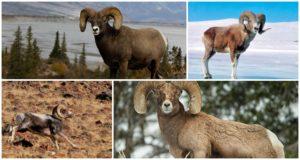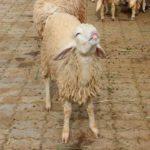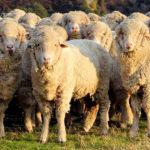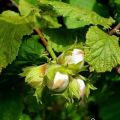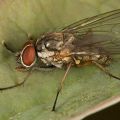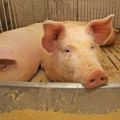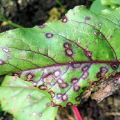Description and symptoms of sheep estrosis, parasitology and treatment methods
Estrosis is an entomotic disease that occurs in sheep as a result of infection with the larvae of a sheep gadfly. Parasites infect the nasopharynx of an animal - they live in the frontal, maxillary sinuses, corneal cavities, ethmoid bones, in severe cases, the brain is involved in the process. Intense inflammation of the epithelium of the upper respiratory tract, in the absence of diagnosis and treatment, can cause a decrease in productivity and death of the livestock.
Insect description
The nasopharyngeal gadflies belong to the family Oestridae, a subfamily of insects from the order Diptera. In sources on parasitology, insects are described as flies about 12 millimeters long, with a yellow head, black large eyes. The color of the abdomen is blue, the legs are short, orange, the wings are transparent. The body of the gadfly is covered with fine hair, which makes it look like a bumblebee. The mouth organs are poorly developed.
The gadfly is able to live from three to twenty days, after which its weight is reduced by a third. Under unfavorable climatic conditions, the insect freezes, the life cycles inside its body slow down. Nasopharyngeal gadflies are viviparous. The female can spray larvae directly on the fly into the nostrils of livestock in large quantities, from where they penetrate into the nasal and frontal sinuses, into the pharynx.
Development stages of the parasite
Gadflies are insects characterized by a closed chain of transformations. The full life cycle is from the larva to the imago stage. The three stages of insect formation differ in characteristic forms:
- Before molting, the larvae of the first stage reach 4-5 millimeters in length and 0.34 millimeters in width. They are whitish in color with two dark chitinous hooks at the front end and with numerous spines scattered throughout the body. By hooks, the larvae firmly attach to the mucous membrane of the nasal concha and ethmoid bone, causing catarrhal and then serous-purulent rhinitis.
- At the second stage of development, the larvae molt, become white, their length is 5-12 millimeters, and their width is up to 3 millimeters. In the spring, being in the frontal sinuses and cavities of the horny processes, the larvae molt again and turn into the third stage. The larva feeds on tissues and body fluids of the host. It dissolves solid components with special dermatolytic enzymes.
- At the final stage of development, the larva of the parasite reaches sizes up to 30 millimeters in length and 3-10 millimeters in width.Two spiracles are located at the posterior end of the larva's body. With the onset of warm, stable weather, the gadfly larva migrates in the opposite direction, falling into the nasal cavity, from where, when a sheep sneezes, falls to the ground, buries itself in the soil and pupates.

The pupa is colored dark gray, then takes on a brown tint. Its dimensions are 12 millimeters long, 5 millimeters wide. At the upper end of the pupa, there is a lid through which an adult formed insect (imago) emerges. Development takes from two days to two weeks.
Symptoms of estrosis
Of the total number of larvae that have invaded the mucous membrane of the sheep's respiratory tract, only about 20% reach the following developmental phases. The rest die and come out together with nasal mucus during sneezing and snorting of the animal in the first stage. The introduced parasites are fixed on the mucous epithelium, leading to injury and intense inflammation, the release of mucopurulent contents from the nasal passages.
The main sign that estrosis will soon begin among sheep is a noticeable change in the behavior of the livestock. Animals huddle together, look frightened and restless, shake their heads down, step over their limbs. 2-4 days after the attack on the sheep by the female gadfly, the larval development cycle begins.

The first symptoms of infection appear in livestock 5-6 days after the invasion. The main signs of estrosis include:
- frequent sneezing and snorting of sheep - this is how they try to free the nasal passages from the parasite larvae that have got there;
- a sharp increase in the amount of exudate secreted from the nostrils - immediately after infection it has a mucous, liquid consistency, after which it becomes thick, with an admixture of pus;
- engorgement and swelling of the nose near the nostrils - a crust of drying serous-purulent discharge forms along their edges;
- shortness of breath with constant snoring - observed due to narrowing of the lumen of the nasal openings, intense inflammation of the mucous membrane;
- enlargement of the submandibular lymph nodes;
- heat;
- deterioration of the animal's condition, loss of strength.
In the advanced stage of estrosis, the lining of the brain is affected. Against the background of general intoxication and damage to the brain structures, coordination of movements is disturbed, convulsive seizures are possible. Sick sheep lag behind the herd, make manege movements. In a severe form of pathology, the animal has paresis (a decrease in muscle strength) and paralysis of the limbs; in the absence of treatment, death occurs after 3-5 days.
Diagnostic methods
An experienced veterinarian can diagnose estrosis in rams by a combination of clinical signs. Sometimes a test irrigation of the nasal passages with insecticidal solutions is required - while the larvae fall out into the external environment. An intradermal test (allergic research technique) can be performed. Differential diagnosis is important - sheep estrosis is often confused with coenurosis. But, unlike estrosis, with coenurosis, animals do not have a runny nose and nasal discharge, but only focal thinning of the cranium is present.
Estrosis can be diagnosed after the death of a sheep - inside the mucous membrane of the respiratory tract there are larvae measuring 12-15 millimeters.
Estrosis treatment
There are several effective drugs that have almost 100% effect on gadfly larvae:
- "Tsiflunit Flock" is a preparation in the form of a spray with a volume of 500 milliliters, completely ready to use. On the skin along the spinal column, it is enough to apply 7 milliliters of the product to provide 4 weeks of protection from insects;
- "Ivermek" is an injectable medication, which contains the component ivermectin and vitamin E. One injection is given with the drug, the second injection is repeated after 8 days.Substances are quickly absorbed, there are no seals and abscesses at the injection site. In addition to gadflies, the remedy is used to combat nematodes that affect the stomach and intestines, lice, ticks;
- "Clozatrem" is an injection-type drug based on closantel. Thanks to this component, already 10 hours after the first injection, you can get rid of the invasion of gadfly worms, nematodes, trematodes and other parasites;
- "Butox" is a product with insect and acaricidal properties. It is a light yellow oily liquid that dissolves in water. Apply the drug in a diluted form, by spraying or bathing.

Timely initiation of estrosis therapy will eliminate larvae in the nasal sinuses of sheep, minimize clinical manifestations of the disease and prevent mortality of the livestock.
Prevention of occurrence
As a prophylaxis for the disease of sheep with estrosis, it is recommended to regularly inspect the places where livestock are kept for pupae and adults of the gadfly. It is useful to install insect shields near the flock, having previously treated them with whitewash with the addition of insecticides.
Early treatment of cattle with "Clozatrem" or "Ivermek" preparations will help protect sheep from attacks by gadflies. Use protective equipment and inspect pens for pupae and adult insects regularly from May to September.
